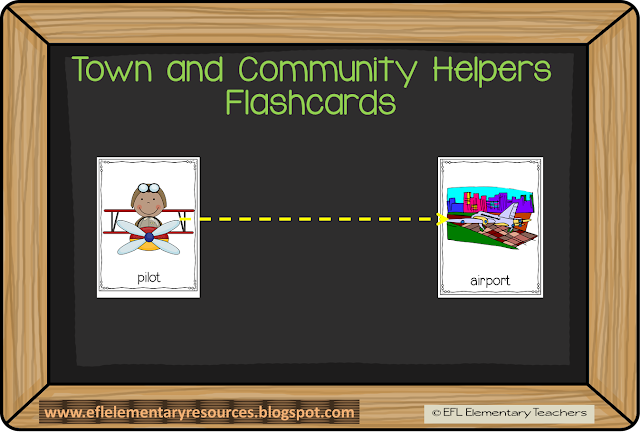Link: https://www.teacherspayteachers.com/Product/Town-and-Community-Helpers-plus-transportation-themes-for-the-ESL-learner-3735921
The resource is also available here: https://www.bilingualmarketplace.com/products/town-and-community-helpers-plus-transportation-themes-for-the-esl-learner?variant=36958760304804
The resource is also available here: https://www.bilingualmarketplace.com/products/town-and-community-helpers-plus-transportation-themes-for-the-esl-learner?variant=36958760304804
In this blog post we will relate the community helpers to where they
work and add their transportation.
Introduce the buildings using the flashcards.
Ask the students who works in each building.
Match the building flashcard (school) to the community helpers (teachers) and people (students) flashcards. In this example more than person goes to the same building.
Now, make sentences.
Teacher: What is this?
Students: It´s the
Hospital.
Teacher: Who works in a hospital?
Students: The nurse and the doctor.
More questions.
Teacher:
Who is he ?
Students: He is the pilot.
Teacher:
Where is the pilot?
Students: He is at the
airport.
Place all the people flashcards
on one side and the buildings on the other.
Say the name of a community
member and the students have to answer with the work place and then the
opposite.
Teacher:
farmer!
Students:
Farm!
Teacher:
theater!
Students:
ballerina!
Let´s pretend. Have the students pick a community helper and the
corresponding work place and stand in front of the class holding a flashcard in
each hand.
Teacher:
Who are you ?
Student:
I am a firefighter.
Teacher:
Where are you ?
Student:
I am at the fire station.
Where are you going to? Give several students a community member necklace and give
the building flashcards to the other group. They stand in front of each other
in random order.
Teacher:
Who are you ?
Student:
I am a clown.
Teacher:
Where are you going to?
Student:
I am going to the circus. (and walks to the corresponding flashcard)
I made small cards for the same matching exercise. Give several groups the same set of cards and ask
the children to match the cards in the shortest period of time. The first group
to finish is the winner.
Place the building flashcards and the transportation cutouts for each
one on a desk. Give instructions.
Teacher: There is an ambulance in front of the hospital. There are two fire trucks, one is next to the fire station and the other is in front of the fire station.
Teacher: There is an ambulance in front of the hospital. There are two fire trucks, one is next to the fire station and the other is in front of the fire station.
And I made people and transportation cutouts. I glued them onto toilet
paper rolls and I used longer rolls for the flashcards.
Teacher: There
is an ambulance in front of the Hospital.
Teacher: There
are two ambulances in front of the Hospital.
More examples to say to the students and have them locate the
ambulances.
Teacher: There
is an ambulance in front of the Hospital. There is an ambulance next to the
Hospital. There is ambulance behind the Hospital.
Teacher: The doctor and the nurse are in front of the
Hospital.
You can do more locations using the cutouts set.
There is more on this resource:
Follow me for more!



























































